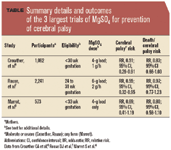Using magnesium sulfate for fetal neuroprotection
Magnesium sulfate administered to mothers delivering prematurely can protect offspring against cerebral palsy.

Key Points
Cerebral palsy refers to a group of related disorders that are caused by nonprogressive damage to, or dysfunction of, the developing fetal or infant brain. The hallmark of cerebral palsy is abnormal control of movement or posture that results in limitation of activity.1 Cerebral palsy is a leading cause of chronic childhood disability, affecting more than 200,000 American children between the ages of 3 and 13 years.2
Preterm birth is a major risk factor for cerebral palsy, with infants born at the threshold of viability being 70 times more likely to be diagnosed with the disease than those born at term. In fact, almost half of all children with cerebral palsy were born preterm.3
Karin Nelson, MD, and Judith Grether, MD, were the first to report that magnesium sulfate (MgSO4) administered to mothers delivering prematurely protects their offspring against cerebral palsy.4 In their case-control study, the authors reported that children with cerebral palsy were much less often exposed to MgSO4 than were those without the disorder (odds ratio [OR], 0.14; 95% confidence interval [CI], 0.05-0.51). This protective association was robust and persisted after controlling for multiple confounders. Moreover, the association was biologically plausible because magnesium can reduce vascular instability, lessen hypoxic damage, and protect against cytokine or excitatory amino acid damage-all threats to the vulnerable preterm brain.5
In the first trial, Crowther et al evaluated 1,062 women expected to deliver before 30 weeks' gestation.6 The women allocated to MgSO4 received the agent as a 4-g intravenous (IV) bolus infusion for 20 minutes, followed by a maintenance infusion of 1 g per hour for up to 24 hours. The risk for moderate or severe cerebral palsy, defined as the inability to walk unaided by 2 years of age, was significantly lower among children in the MgSO4 group (3.4% vs 6.6%; relative risk [RR], 0.51; 95% CI, 0.29-0.91; P=.02). In addition, stillbirth delivery or death before 2 years of age occurred less often among the children of women randomized to MgSO4 (13.8% vs 17.1%; RR, 0.83; 95% CI, 0.64-1.09), although this difference was not statistically significant.

In the third large trial, conducted in France by Marret and colleagues,8 the authors randomly allocated 573 mothers to either a 4-g IV bolus of MgSO4 or placebo. Children of women who received MgSO4 had a lower risk for cerebral palsy (7.0% vs 10.2%; RR, 0.69; 95% CI, 0.41-1.19) and a lower risk for death (9.7% vs 11.3%; RR, 0.85; 95% CI, 0.55-1.30). Although these differences are not statistically significant, the risk reductions reported in this trial were similar to those observed in the 2 previous studies (see Table).
